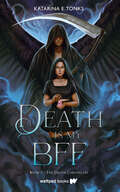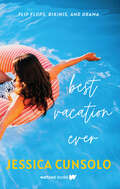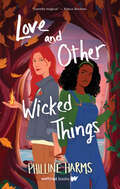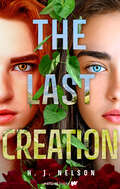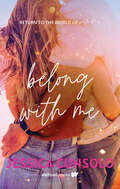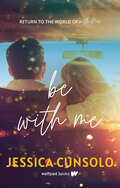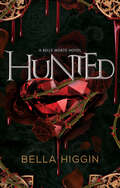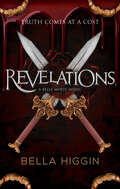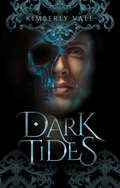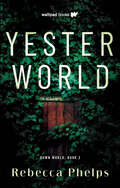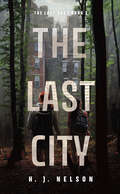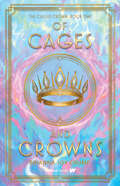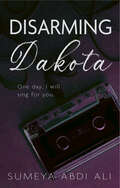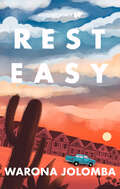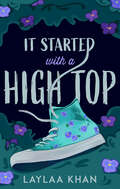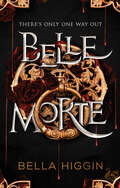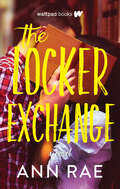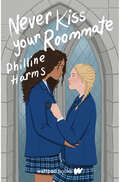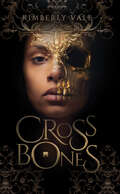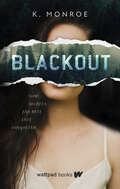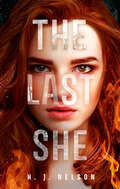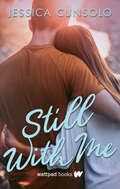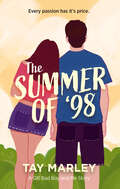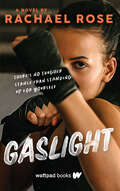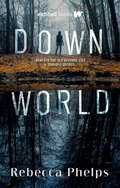- Table View
- List View
Death is My BFF (The\death Chronicles Ser. #1)
by Katarina E. TonksWhen Faith Williams almost loses her life during a robbery, Death is there. While he spares her soul, he makes a promise to return when she’s eighteen and collect it.Now it’s the eve of that special birthday, and Faith has no recollection of that fateful day. But echoes of Death appear in her art—his intense eyes, his intriguing demeanor—and she can’t get him out of her head. When he arrives in person, Faith is drawn into an epic supernatural battle where her very existence is questioned at every turn.To add angst to agony, she meets the infamous David Star at a Halloween party, and he begins to show an interest in her. He’s handsome, rich, ambitious, and every girl’s dream, but Faith doesn’t know if she can trust him.As Faith learns more about who David really is, and as Death pushes harder for her soul, an ancient prophecy emerges. When she discovers the secrets that bind all three together . . . all hell breaks loose.
Best Vacation Ever
by Jessica CunsoloTwo best friends, five hot guys, one dream vacation. What could possibly go wrong?Lori is beautiful, smart, and athletic. The one thing she can’t do is speak up for herself: she can’t stand up to a creepy guy at the gym, she can’t speak to her crush, and she certainly can’t tell her parents that she wants to take a year off to backpack around Europe rather than follow family tradition and go to med school. When her best friend, Faye, invites her on an all expenses paid, weeklong trip to a sunny destination with Faye’s brother, Adam, and four of his friends, she jumps at the chance to leave all her problems behind.Faye is Lori’s opposite in a lot of ways—maybe that’s why they’re such good friends. In fact, the only problem in Faye’s life is that her brother hates her, and she’s hooking-up with his best friend, Kellan, behind his back. She can’t let Adam find out. as that’ll only make their relationship worse. At the same time, she doesn’t want a hook-up; she wants a real relationship with Kellan. This vacation is her chance to figure out if he’s in this for real or not.When Faye hatches a scheme designed to make Kellan jealous, she drags everyone else into her drama—including Lori and her gym crush, who just happens to be on this trip too! Soon everyone is fighting with everyone else and relationships are being ripped apart as secrets are revealed. Going on the Best Vacation Ever may turn out to be the Worst Decision Ever.This delightful, stand-alone novel from YA superstar Jessica Cunsolo deals with romance and friendship, but it’s also about learning to stand-up for yourself and be who you want to be.
Love and Other Wicked Things
by Philine Harms"Sweetly magical." — Kirkus ReviewsSometimes love is the strongest magic of allNineteen-year-old Rhia Greenbrook has lived in the sleepy town of Oakriver in a house with three generations of witches her entire life. Rhia draws her magic from the earth and likes to spend her time amongst plants and nature. Her practice is gentle, sacred, and—per her family’s tradition—secret.New-to-town witch Valerie Morgan is looking for answers about her mother’s disappearance from Oakriver seventeen years ago. Without her mother’s guidance, Valerie has cultivated her fire magic on her own and she makes no effort to keep her powers hidden. Although Rhia is immediately annoyed by Valerie's blatant use of magic, she can’t deny the instant magnetism between them.But amidst their magical connection, a dark presence looms over Oakriver. Unsettling visions from Rhia’s grandmother and dangerous sleepwalking episodes throw into question Valerie’s past and what role her presence plays in the strange happenings. And as Valerie gets tangled up further into the darkness, it’s up to Rhia to tap into the full potential of her power in order to save the town she loves and the girl she’s fallen for.
The Last Creation
by H.J. NelsonThe final installment of The Last She series finds Ara, Kaden, and Sam reunited . . . only to face their toughest adversary yet: the Creation, a selection of clones who are hell-bent on destroying humankind. It&’s up to the three of them to save what&’s left of humanity before it&’s wiped out . . . again.In the final installment of H.J. Nelson&’s dynamic The Last She series, Ara, Kaden, and Sam risk everything to save what&’s left of the world when it&’s threatened by the Creation. Ara and Kaden are above ground. Now that they know the truth, they want nothing more than to move forward. To find their way in this new world, together. They also want to find their way back to Sam, who is both alive and back with the clan. They all want their happy-for-now ending.The Creation have other plans. They, too, want to exist above ground—but in a world that does not include humans. The battle will happen and only one side can win. Will Ara be the last one standing again, or can she, Kaden, and Sam save what&’s left of humanity?
Belong With Me (With Me Ser. #5)
by Jessica CunsoloIn the gripping sequel to BE WITH ME, Jessica Cunsolo takes us back to the world of With Me.When Siena Amato moved to King City, all she wanted to do was take care of her sister, maybe reconnect with her long-absent father, and keep her head down and her grades up. She never expected to become the prime suspect in a classmate’s disappearance–at least in the eyes of the girl’s police officer father–or to fall for Jason Parker.Jason is everything Siena doesn’t need right now. Yes, he’s handsome, very handsome. And he’s kind and thoughtful, but he’s also got a reputation for drag racing and evading the law. Being around him isn't a good idea for a girl who is already fighting to convince everyone that she’s innocent and just wants to avoid the drama.However, Siena can’t ignore the attraction between them, and Jason actually believes her. As their friend’s disappearance remains a mystery, the pair are even more determined to discover the truth and clear Siena’s name. But as they dig deeper, they may be risking everything including their hearts.
Be With Me (With Me Ser. #4)
by Jessica CunsoloJessica Cunsolo’s With Me series continues with Jason and Jackson Parker who are all grown up now and ready to follow in their brother Aiden's footsteps.Sisters Siena and Gia Amato have just moved to King City. On their first night in town, Siena is almost run over by the devastatingly handsome Jason Parker who’s trying to evade arrest after getting caught drag-racing by the police. While the circumstances of their meeting are less than ideal, Siena can’t deny the instant attraction she feels for him—even if it goes against every one of her “good girl” instincts. When a classmate goes missing and Siena’s life is endangered, she and Jason are thrust together. Suddenly, the stakes are even higher, and more than their hearts are on the line.Jessica Cunsolo’s trademark blend of romance and mystery will appeal to fans of Aiden and Amelia’s story as well as new readers.
Hunted (Belle Morte Ser. #3)
by Bella HigginIn the third installment of the Belle Morte series, follow vampire Ludovic and human Roux who are on the hunt to bring renegade vampires to justice while denying the complicated feelings for one another.With the help of Renie and Edmond, the battle for Belle Morte has been fought and won. However, the bigger fight is not over, as enemy vampires have escaped into the city and the future of vampirekind hangs in the balance. The escapees must be brought to justice - and fast.For fellow Belle Morte celebrity, the reclusive vampire Ludovic de Vauban, this is the perfect opportunity to confront his fears about the world beyond the mansion's walls. But he can't do this alone. Enter donor Roux Hayes;. accomplished liar, quick thinker, and street savvy human. She can help Ludovic navigate a world that has long since left him behind.As the unlikely duo work together to preserve a future for their friends, they discover a mutual passion that neither of them expected, one that burns hotter than anything either of them have ever experienced. But the shadow of old enemies stretches longer than they ever imagined and threatens not only every one they love, but also the new love they have found in each other.
Revelations (Belle Morte Ser. #2)
by Bella HigginTruth comes at a cost.Ever since Renie Mayfield survived the merciless attack on Belle Morte that killed donors and vampires alike, she is forever changed. Now a vampire, the agonizing transformation of her body and mind is rivaled only by uncovering the horrific truth about her sister, June, who has escaped the mansion in her rabid form, adding even more chaos to Renie’s reality.As the vampire responsible for Renie’s change, and now her distress, Edmond Dantes remains in his own desperate place. He’s confined in the secret cells of Belle Morte, awaiting the arrival of the council and the subsequent punishment for his actions. Edmond questions if what he did was right and deeply regrets what has become of his home.Desperate to free Edmond, find June, and bring justice to whoever is behind the recent violence, Renie is out for blood in more ways than one. The smell of corruption is embedded in the walls of Belle More, but behind the walls are even more secrets that may lead to the truth and to justice.
Dark Tides (Kingdom Of Bones Ser. #2)
by Kimberly ValeWhen love is an anchor, the sea can swallow you whole.Csilla Abado has a full plate after becoming the first Queen of Bones. While leading Cerulia, sending fleets to hunt for Dominic Rove, and recruiting new crews to the cause, she must also find a way to mend the lingering crack between Limbo and the mortal realm. Otherworldly creatures are spilling through, threatening more than just the island kingdom. When Lorelei and Nara go missing, the crew takes sail once again to find them and stop the worst of the villains, Magnus, before he can slip through the crack. As their leader, Csilla takes every decision head-on, but her sister's death weighs on her, and if she doesn't learn to let go, she could end up alone in her fight.After the events at Crossbones, Kane Blackwater is desperate to find the traitorous Dominic Rove, but when his desperation sends him to Death's Cove, he's met by creatures that should be locked away in Limbo. He returns to Cerulia with this knowledge and an evil, magic-laced wound that’s slowly seeping through his body. When Lorelei suddenly goes missing, he joins the search, but his time is running out and he must decide what's more important to him: her life or his own.Lorelei Storm isn't the same since her return from the realm of Limbo. A menacing and powerful magic rests under her skin, and she fears it as much as she craves its potential. She tries to keep this secret from her found family, but when she accidentally hurts someone, she finds she can no longer hide her ability. She flees only to be caught, alongside Csilla’s first mate Nara, by an Incendian Scout and taken as prisoner. But Lorelei finds out the scout is also an emberblood, and if she must, she will use her enemy to learn how to control her powerful new magic.Jaron Thorne was raised to hate and hunt pirates. Becoming his fire god's champion and wielding his obsidian sword has given him even more purpose in ridding the kingdoms of every last pirate. Fighting runs through his veins, but when Magnus's whispers send him to steal away the only living stormblood, he ends up taking an extra captive: an archer whose frosty demeanor intrigues him as much as he hates it. But as he learns more about the world he thought he knew, Jaron must learn to control his inner-flames or risk burning down everything around him, including his chance of finding his lost brother.As the war between gods and mortals builds to a crescendo, Csilla, Kane, and Lorelei must not only protect their world from destruction, but also their hearts from looming devastation. The seas darken and not everyone will survive the rising tides.
Yesterworld (Down World Ser. #2)
by Rebecca PhelpsIn the sequel to Down World, Marina is lured back through the doors by a mysterious man.“Time after time I come back to this cold brick door. Sealed, as it has been for over a year now, as I know it must remain forever. I don’t know why I keep doing this to myself. I know I can never open the door to Yesterday again. I can never have Kieren back. Never talk to Brady about the things we saw under the lake all those months ago. And never tell my brother Robbie how my heart broke every day that he was trapped in the abyss lurking behind those immovable bricks.Maybe I come to this room the way some people visit gravestones. The three doors are all I have left of my loved ones now. The rough, hard rectangles and their merciless mortar, staring back at me. Yesterday. Today. Tomorrow.And me in the waiting room.To open any of these doors is to open a pathway to death. I know this. And yet, they call to me.”Eighteen months have passed since Marina O’Connell first discovered the doors, and her life changed forever. She’s a senior now. And she’s living in a plane of reality with her stepmom and her dad, while Robbie and her mom are in Oregon. She and her best friend Christy are making plans for college. They’re crushing on Mr. Martel, the new history teacher. He’s young enough to inspire them to take the subject seriously, but there’s more to him than good looks. He isn’t who he seems, and when he confronts Marina with the secret they both share, she realizes that she can’t, or won’t, turn away from the doors that have been calling out to her for months.
The Last City (The\last She Ser. #2)
by H.J. NelsonIn the highly anticipated sequel to The Last She, Ara, Kaden and Sam must learn the first rule of the apocalypse: Trust NO one.AraIs desperate to reunite with her father and put the events that happened in Boise behind her. Ara hopes to find sanctuary in The Last City, an almost-mythical place where the plague is nonexistent and she can finally discover the truth about her family. Once she arrives, she discovers the truth is stranger than fiction, and Ara wonders if she’s made a huge mistake . . .KadenWill go anywhere for Ara, will do anything, but he’s tested to his limits in The Last City. Forced to join a dangerous expedition, Kaden soon finds himself separated from Ara and, once again, on the run for his life. Now he needs to risk it all again to find Ara in The Last City . . .SamHas hooked up a rigged electrical system, blasting away the silence with music, feeling almost normal since he nearly lost his life. He doesn’t know where Kaden and Ara are, and when he meets a mysterious girl named E, they embark on an adventure that will bring all of their lives crashing together . . .All three must uncover the secrets of The Last City if they have any hope of getting out of this apocalypse alive.
Of Cages and Crowns (The\culled Crown Ser. #1)
by Brianna Joy CrumpFire at her fingertips. Watch the world burn.When Monroe Benson was born with the power to summon fire from her fingertips, her family knew she had to stay hidden. But when Queen Viera calls for the Culling, an age-old tradition in Erydia where ten goddess-touched girls battle to the death in order to claim the crown, Monroe can no longer hide. She’s whisked away from her home, from her mother, from everything she’s ever known to fight alongside the other girls—each with their own power—for a throne she does not want.Duty is his destiny. There’s no way out.As the son of the queen and the next king, Cohen can’t question tradition. Not even when he’s being mysteriously poisoned. Not even when his sister goes missing and no one seems to care. The Culling makes choices for him—who will become his wife, who will rule by his side. And when rebellion rises, what little control Cohen has over his future is threatened.Together they’ll stand. Together they’ll fall.But Monroe sees a different Cohen than the rest of the world. She sees him as more than just the crown, more than just the next cruel ruler in a long line of cruel leaders. In turn, he sees her as more than just her powers. More than just a goddess-touched girl destined to lose her life. When a betrayal threatens both their relationship and the monarchy, Monroe and Cohen face a choice that will change their lives . . . forever.
Disarming Dakota
by Sumeya Abdi AliAs Sylvia Ellington is about to start her senior year, her mother decides to have her move in with her aloof father and his "perfect" family in California. Sylvia promises to be on her best behavior, and for the most part, she's able to keep her snappy attitude in check . . . until she ends up at a party one chilly night where she meets a tattooed boy named Dakota. Sylvia knows she&’s in trouble because Dakota&’s ungodly tall with crystal blue eyes that can sway any good girl to do bad things. Dakota has got reasons for avoiding Sylvia–and he goes out of his way to show her that she&’s not the one for him. Yet, she&’s determined to disarm this bad boy and unlock the secrets trapped deep inside. Before they know it, Sylvia and Dakota embark on an emotional roller-coaster of a relationship that is bound to ruin a few lives. When Sylvia own past comes knocking on her door, it threatens to destroy what she and Dakota have built. All they need to do is hold on and not let their secrets tear them apart.
Rest Easy
by Warona JolombaWords have the power to heal"We're not friends. We're just volunteer partners.Once our shift is over, we don't know each other.""I hate you sometimes.""What about the rest of the time?"" . . . the opposite, I guess."Heartsick from the death of his mother and heartsore from breaking up with his girlfriend, Dee Warrington is barely getting by. Eccentric with mad style, Naya’s had straight As since the seventh grade, and when she makes a pinky promise, she means it.Both find themselves at Salvation Hill Nursing Home, volunteering during their summer break. There they meet Marie Delden—a former aspiring poet with a mysterious backstory. As Dee and Naya read through Marie’s poems, they begin to unravel Marie’s past . . . and discover their own future.Inspired by a true story, Warona Jolomba shares a tale of love and loss, and a bond that forms in the unlikeliest of places.
It Started With a High Top
by Laylaa KhanSometimes, Cinderella has to take matters into her own hands to get her shoe back.Annabelle (known as Anne) has had a favorite pair of high tops for years. They belonged to her mother and when she wears them she feels especially connected to her mom, a divorced Egyptian immigrant raising four kids and working long hours at the hospital. These shoes are Anne&’s super power. But then one day one goes missing from her gym locker. Her search for the missing shoe forces her to enlist the help of her brother&’s best friend, Hunter. Anne has always had a crush on Hunter, but he&’s never really thought of her as anything other than a friend. However, as they spend more time together both at their jobs in a local bakery and looking for Anne&’s lost shoe, he&’s left wondering if they could be more.In fairytales, it&’s usually the prince who saves the day, but this princess is going to have to rescue herself—and maybe the prince as well—if she&’s going to get a happily ever after.
Belle Morte (Belle Morte Ser. #1)
by Bella HigginThere’s only one way outBelle Morte. One of five houses where vampires reside as celebrities and humans are paid to be their living donors. While others came here seeking fortune, I came in search of my sister who walked into Belle Morte five months ago . . . and never walked back out.Now that I’m here, the secrets about this world have proven to be much bigger than I ever anticipated. And lurking around every corner are shocking insinuations of what happened to my sister.There’s only one person who might have the answers I need, and the undeniable pull I feel toward him is terrifying: Edmond Dantès—a vampire, and my mortal enemy.The harder I try to resist him, the further I fall under his spell. And in one instant my life is irrevocably changed. My past becomes prologue and my fate becomes sealed behind these doors.Belle Morte has spoken. And it may never let me go.
The Locker Exchange
by Ann RaeFor Westwood junior Brynn Cadence, high school drama is taken to a whole new level when she discovers the dead body of a classmate on the football field one Friday night. When she tells the police she saw a masked figure fleeing up the bleachers, they dismiss her and label the death accidental.With no one believing what she saw, Brynn’s internal walls start to go up. But there’s one wall she has no control over—the one that separates her and Kyler Fellan’s gym lockers. That’s right, Brynn opens her locker only to find herself face-to-face with the shirtless abs of the school’s star football player and resident flirt.While not an unwelcome surprise, Brynn knows she should leave her fluttering feelings for Kyler on the locker room floor in order to focus on exposing the truth of her classmate’s death. But Kyler’s top jock status has made him privy to some potentially useful gossip, making him a helpful and trustworthy partner in her investigation. As two find themselves delving deeper into the case, they are inevitably drawn closer to each other—even if that isn’t safe for either of them.
Never Kiss Your Roomate
by Philine HarmsWelcome to Seven Hills, the world’s most exclusive boarding school where only the best and brightest roam the hallowed halls. Being committed to your studies, service, and community doesn’t mean that you can’t break the rules now and again, right?But watch your back because lurking on the anonymous Chitter Chatter Blog is The Watcher—who can’t wait to reveal all the latest hookups, hot lists, and secrets around campus. The latest objects of The Watcher’s affection? Straight-off-the-train (but not exactly straight) insta-besties Evelyn and Seth.It doesn’t take long for Evelyn to realize she is inexplicably drawn to her gorgeous and standoffish roommate Noelle. Meanwhile Seth has eyes, and some serious heart palpitations, for budding thespian and school flirt Jasper. Just as things start to heat up, The Watcher strikes. Will the secrets revealed turn their happily ever afters into happily never afters?
Crossbones (Kingdom Of Bones Ser. #1)
by Kimberly ValeNever trust a pirate.The Blood Bell tolls, marking the death of the pirate king and the start of the Trials—a heart-stopping competition where the reward is the Bone Crown. Only one contender can claim the coveted island throne; each will gamble life and limb to win.Captain. Sister. Maiden.Csilla Abado yearns to prove her strength to the seasoned pirates who balk at her youth and to her elder sister who has always craved Csilla’s captainship. She will risk everything to become the first pirate queen, no matter the cost.Dealer. Son. Legacy.Kane Blackwater wants to leave behind the dirty gold and shady trades he’s made to keep his father’s ship, the Iron Jewel, alive. The Trials represent a new beginning—yet rumors of a secret heir are swirling, threatening his hopes of becoming the pirate king.Stowaway. Daughter. Storm.Lorelei Penny longs for nothing more than to avenge her mother’s death. Stowing away on the Iron Jewel was supposed to get her closer to the killer, but instead she finds herself caught up in the deadly battle where loyalty and desire collide.Csilla. Kane. Lorelei. Each on a mission. The sea, however, has other plans. Dark tides are rising, and if they aren’t careful, they’ll surely drown.
Blackout
by K MonroeSome secrets are best left forgotten.When Allie Castillo wakes up after a terrible car accident, with head injuries and zero recollection of who she is or what happened, one thing haunts the edges of her mind: the crash may not have been an accident.Her body still bruised, she returns to a life she doesn’t recall, to a house that’s unfamiliar, and to a family that doesn’t feel like her own. School is another minefield—her boyfriend wants his girl back, her best friend wants to carry on their old partying ways, and the mysterious guy at the back of the classroom wants nothing more than to unlock the door to her forgotten memories.As Allie learns about her notorious past, she grows to dislike who she was pre-accident. She’s determined to change, determined not to repeat the same mistakes. But when her life is put in jeopardy once more, Allie realizes that her only chance at survival is to remember who she used to be—even if that means abandoning who she wants to become.
The Last She (The\last She Ser. #1)
by H.J. Nelson2023-2024 Tome Society It List2023 University of Wisconsin Madison English Department Early Career Alumni AwardSurvival is everything. So is love.Ara hasn’t seen another human in months―not since her father disappeared. As the only female to survive a devastating virus, her world is haunted by the ghosts of her former life. Her mother. Her sister.Kaden and his crew live by a code: stay alert, stay alive. When they catch Ara trying to steal from them, they are furious―and confused. She’s the first girl they’ve seen in three years. And while Kaden knows taking her captive is wrong, he tells himself it’s for her protection. That the only place she’ll be safe is with the clan, his new home. The world of men.However, Ara is determined to discover the truth about the plague, and nothing will stop her. And as Kaden becomes mesmerized by her will and beauty, he realizes that he will do anything to help her, even if it tears their worlds apart.But the world of men isn’t prepared for The Last She, and the odyssey to save themselves means Kayden and Ara have to leave behind everything they’ve come to know. To burn it down to the ground. In the ashes they can start again.
Still With Me (With Me Ser. #3)
by Jessica CunsoloTogether . . . until the very endJessica Cunsolo’s epic romance that began in She’s With Me comes to a heart-stopping conclusion.Love has never been easy for Amelia Collins and Aiden Parker. They’ve faced every imaginable challenge: car wrecks, stalker attacks, evil fathers, wicked rivals, falling for each other, and finally giving in to their feelings.So it’s no surprise that just as Aiden and Amelia begin to plan their future, a new threat emerges that could destroy everything. As Amelia once again attempts to protect those she loves, she inadvertently leaves a trail of clues behind, and her stalker is hot on her trail.Faced with an impossible choice between love and survival, Amelia and Aiden’s devotion to each other is tested like never before. But it may be no match for a cold-blooded killer.The thrilling finale in the With Me series is sure to take your breath away . . .
The Summer of '98: A Qb Bad Boy Novel (A\qb Bad Boy Novel Ser. #2)
by Tay MarleyEvery passion has its price.Before Drayton and Dallas, there was Ellie and Leroy . . .With the prequel to her smash hit The QB Bad Boy and Me, rising star Tay Marley returns to tell the story of Drayton’s parents and the summer that changed everything . . .Sometimes home isn’t a place, it’s a person. From the moment their eyes met, Ellie knew he would be her destiny. Handsome and ripped, there’s just something about Leroy Lehay, Baylor University’s soon-to-be star quarterback, that makes him impossible to resist.Consumed by a passion neither one of them can quite understand, Leroy and Ellie spend the summer together. Left senseless and overwhelmed by his touch, Ellie experiences a world of desire she could never have imagined.Safe in Leroy’s arms, Ellie begins to see a life beyond high school: going to college, starting her own business, having a family. But when life-altering news shakes them to their cores, Leroy and Ellie must discover if their passion is enough to help them get through what might possibly be the greatest challenge of their lives.
Gaslight
by Rachel RoseEveryone has a limit.It’s a six-hour flight from New York City to Los Angeles.For Maddie Goodwright and her mom, it’s six hours that will change their lives as they leave behind broken relationships and shattered dreams. But a new school, a new home, and a new group of friends can’t heal the wounds of the past. To move forward, Maddie will have to reinvent herself.When Maddie’s step-cousins take her to the local underground fight club, it’s only a matter of time before boxer Hayden Walker catches her eye. Strong, powerful, and confident—he’s everything Maddie isn’t, but definitely wants to be. Convincing Hayden to train her is hard, not falling for him will be even harder.As Maddie transforms both inside and out of the ring, her past returns with a vengeance determined to ruin everything. Except this time he’s not ready for her to face him head on.
Down World (Down World Ser. #1)
by Rachel PhelpsWould you destroy another world to save your own?As the site of a former military base, there have always been rumors that East Township High School was the site of experiments with space and time. For years, students have whispered in the hallways of a doorway created within the school, one that can access multiple timelines and realities, a place known as the Down World.As the new kid in school and still reeling from the unexplained death of her brother Robbie, Marina O'Connell is only interested in one thing: leaving the past behind. But a chance encounter with handsome Brady Picelli changes everything. He will lead Marina to a startling discovery. The Down World is real and the past, present, and future are falling out of balance.Brady is determined to help Marina discover what really happened to her brother. However, what is taken from one world, must be repaid by another. And Marina is about to discover that even a realm of infinite possibilities has rules that must be obeyed.
